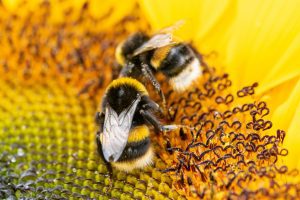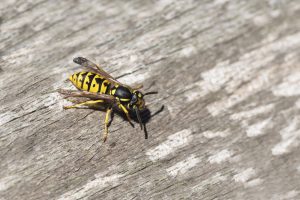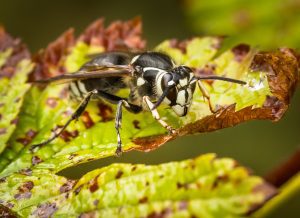Differences Between Hornets, Wasps & Yellow Jackets & How To Identify
Serving Atlanta Metro | Columbus | Augusta | Savannah

Summertime fun means spending time outside, and whether you’re hanging out at the pool, going for a hike, or hosting a backyard barbecue, nothing raises the anxiety level quite like the sudden appearance of stinging insects.
When stinging insects crash the party, your first step is to ensure everyone’s safety by calmly moving away to avoid provoking them.
Knowing which stinging insect you’re dealing with can help you take the right action.
In most cases, it’s a wasp, hornet, or yellowjacket that causes the buzz. While these insects can look alike, each has distinct traits. That’s why this guide is here: to help you quickly tell stinging insects apart and better understand how to manage the situation safely.
Common Stinging Insects in Georgia
In Georgia, the warm climate and lush greenery make it a haven not only for people but also for stinging insects. These pests are often drawn to yards and homes by the promise of food, water, and shelter, making them a common nuisance during outdoor activities. While some are harmless or even beneficial, others can be highly aggressive, making it important to identify and understand their behaviors.
The following outlines the most common stinging insects you’re likely to encounter in Georgia, their basic habits, and how aggressive they tend to be:
 1. Bees – Bees are the best-case scenario for stinging insects. They are rarely aggressive, excellent pollinators that bring many benefits to your garden, and are easy to identify with their rounded, fuzzy bodies. There are a few different types of bees you may find including bumblebees and honey bees.
1. Bees – Bees are the best-case scenario for stinging insects. They are rarely aggressive, excellent pollinators that bring many benefits to your garden, and are easy to identify with their rounded, fuzzy bodies. There are a few different types of bees you may find including bumblebees and honey bees.
 2. Mud Daubers – Mud daubers build nests from mud. They are mostly black but may have light-colored markings, with a narrow waist. A type of solitary wasp, they aren’t aggressive and will only sting when directly handled.
2. Mud Daubers – Mud daubers build nests from mud. They are mostly black but may have light-colored markings, with a narrow waist. A type of solitary wasp, they aren’t aggressive and will only sting when directly handled.
 3. Paper Wasps – Known for the papery nests they build, often hanging from tree branches, porch ceilings, and door railings. Paper wasps aren’t as aggressive as yellowjackets, but they will sting to defend their nests. Their sting hurts.
3. Paper Wasps – Known for the papery nests they build, often hanging from tree branches, porch ceilings, and door railings. Paper wasps aren’t as aggressive as yellowjackets, but they will sting to defend their nests. Their sting hurts.
 4. Yellowjackets – An unofficial state mascot of Georgia and infamously aggressive, yellowjackets (or yellow jackets) live in colonies of up to or more than 1,000 workers. If yellowjackets feel threatened, they may sting repeatedly.
4. Yellowjackets – An unofficial state mascot of Georgia and infamously aggressive, yellowjackets (or yellow jackets) live in colonies of up to or more than 1,000 workers. If yellowjackets feel threatened, they may sting repeatedly.
 5. Bald-Faced Hornet: Called a hornet but technically a yellowjacket, bald-faced hornets are fairly large, and often become a problem for humans due to their tendency to make their homes in wall cavities, attics, and structural openings. They are often recognized from the distinctive white markings on their face.
5. Bald-Faced Hornet: Called a hornet but technically a yellowjacket, bald-faced hornets are fairly large, and often become a problem for humans due to their tendency to make their homes in wall cavities, attics, and structural openings. They are often recognized from the distinctive white markings on their face.
 6. European Hornet: The largest stinging and flying insect found in Georgia, the European hornet has a bright yellow appearance and looks very intimidating. They are highly aggressive and will sting multiple times if defending their nest.
6. European Hornet: The largest stinging and flying insect found in Georgia, the European hornet has a bright yellow appearance and looks very intimidating. They are highly aggressive and will sting multiple times if defending their nest.
Say Goodbye to Pest Problems for Good!
Ready for your FREE quote?
Fill out the form below and we’ll be in touch!
*During normal business hours. After hours inquiries will be returned the next business day.
What’s the Visual Difference Between Wasps, Hornets, and Yellow Jackets?
Many people use “wasp,” “hornet,” and “yellowjacket” interchangeably, but there are some key differences.
First of all, “wasp” is actually an order of insects, not a specific species. Yellowjackets, European hornets, mud daubers, and paper wasps are all types of wasps. One easy way to help determine if it’s a wasp is the common characteristic they share: a narrow waist.
Notably, bees do not share this characteristic; they belong to a separate order.
The next step is to narrow it down further to determine whether it’s a yellowjacket, hornet, or another type of wasp. While these insects share some similarities, there are distinct features that make each one identifiable.
- Yellowjackets: Yellowjackets are usually small to medium in size, ranging from ½ to 1 inch long. They have a striking black and yellow coloration, with a very smooth and shiny body.
Yellowjackets have distinct black markings on their faces and abdomens, and their yellow and black striping can resemble a “banded” appearance. These wasps are often mistaken for bees due to their similar color pattern, but their smooth body and narrow waist give them away.
Yellowjackets also tend to have a more angular, elongated shape compared to the rounder look of bees.
- Hornets: Hornets are a type of large wasp, and they are usually larger than yellowjackets—about 1 to 1.5 inches long.
European hornets, for example, have a yellow and brownish color pattern with noticeable black markings on their thorax and abdomen. Hornets tend to have a more robust and stocky body compared to the slim appearance of yellowjackets. Their face may also appear slightly more elongated, and they tend to have a smoother, less patterned appearance on their abdomen.
Additionally, hornets are typically less vibrant in color than yellowjackets, with more muted tones of yellow and brown.
- Paper Wasps: Paper wasps are generally smaller, around 0.75 to 1 inch long, and are known for their elongated, thin bodies and distinctive dark coloration. They often have a reddish-brown or black body with yellow markings.
Paper wasps’ bodies are slender, and their wings are more spread out and slightly angled compared to yellowjackets and hornets. The distinguishing feature of paper wasps is their long, thin legs that dangle when they fly, as opposed to the more compact appearance of yellowjackets and hornets.
Differences In Behaviors Between Wasps, Hornets & Yellow Jackets
While these pests share some similar traits, their behaviors, nesting habits, and aggressiveness can vary significantly:
General Behavior
Yellowjackets: Yellowjackets are highly active and often seen flying around trash cans, food sources, or near sugary drinks. They are social insects that live in large colonies and tend to be more aggressive when they feel threatened.
Hornets: Hornets are also social insects but are generally less active around food sources than yellowjackets. Hornets are more likely to be encountered near their nests, where they are highly protective.
Paper Wasps: Paper wasps are relatively calm and less aggressive than yellowjackets and hornets. They are often seen flying slowly around their nests, typically in trees, under eaves, or around porch ceilings.
Nests
Yellowjackets: Yellowjackets usually build their nests underground, in abandoned rodent burrows or other hidden areas such as wall voids or attics.
Hornets: Hornets typically build their nests in trees or shrubs, but they are also known to create nests in attics, wall cavities, or any protected area. Their nests are large, football-shaped, and made of papery material.
Paper Wasps: Paper wasps build their nests in sheltered areas, such as under eaves, in tree branches, or on fences. Their nests are much smaller than those of yellowjackets or hornets.
Curious about stinging insects and their nests? Learn more in our article – How To Identify Wasp & Hornet Nests
Aggressiveness
Yellowjackets: Yellowjackets are the most aggressive of the three. They will sting multiple times if they feel threatened, especially when their nest is disturbed.
Hornets: Hornets are less aggressive than yellowjackets but can become highly defensive (and dangerous) when their nest is threatened. They will sting multiple times if they feel their nest is in danger..
Paper Wasps: Paper wasps are the least aggressive of the three. They will usually only sting if they feel directly threatened or if their nest is disturbed.
By understanding these general behavioral patterns, you can more easily identify the type of stinging insect you are dealing with.
If you’re unsure, it’s always best to err on the side of caution and contact a professional pest control service, especially if the nest is near high-traffic areas or in a place that poses a risk to your family.
Contact Active Pest to see how we can help manage your stinging insect problem, today!
What Attracts Wasps, Hornets, and Yellowjackets?
Understanding what attracts hornets, wasps, and yellowjackets to your property is the first step in preventing infestations. These insects are drawn to specific environmental conditions, food sources, and potential nesting sites.
By identifying and eliminating the things that attract them, you can reduce the likelihood of an infestation.
- Food Sources:
One of the primary reasons wasps, hornets, and yellowjackets are attracted to your property is the availability of food. These insects are particularly attracted to sugary substances like fruit, soda, and sweet-smelling foods. If you’re hosting an outdoor gathering or barbeque, leftovers, spilled drinks, or open cans of soda can easily draw them in.
They’re also attracted to protein sources, such as meats, and may become more noticeable in late summer or fall when their colony is large and they are looking for food to sustain their growing population.
- Trash and Garbage:
An accessible trash can or poorly sealed garbage bin is like a magnet for these pests.
Yellowjackets, in particular, will scavenge around trash bins, food scraps, and compost piles. Be sure to store garbage in tightly sealed containers and regularly clean trash bins to remove any food residue that might attract these insects.
- Nesting Sites:
Wasps, hornets, and yellowjackets need sheltered spaces to build their nests. These pests are often drawn to areas around your home that offer ideal nesting conditions. Common nesting sites include holes in the ground, under decks, in sheds, attic spaces, wall cavities, and even gaps around windows or doors.
Wasps and hornets prefer to build their nests in high, sheltered areas like tree branches, roof eaves, and under porch ceilings. They are also attracted to areas with dense vegetation or overgrown shrubs that can provide cover and protection for their nests.
- Cracks and Gaps in the Home:
Any cracks, gaps, or holes in the structure of your home can provide an entry point for stinging insects.
These insects will often find and nest in these areas, especially in places that are undisturbed. For example, small cracks in the walls, spaces around windows and doors, or ventilation openings can give these pests easy access to your home. If left unchecked, a hornet or yellowjacket nest can expand quickly and become a serious issue.
- Flowering Plants and Gardens:
Wasps and hornets are also attracted to flowering plants because they are attracted to nectar. While they are not as efficient at pollination as bees, they will visit flowers for food.
If you have a garden with a variety of blooming flowers or fruit trees, these pests may be drawn to the sweet smells they produce.
Sealing entry points, removing food sources, keeping trash secure, and maintaining your yard can all help prevent these pests from becoming a problem. Regular inspections of your home’s exterior and around your yard are also key in identifying and addressing potential nesting sites before they become an issue.
Summertime Wasp Control
Do you like stinging insects like bees and wasps? If so, Georgia is arguably the best place in the entire United States to live. If not, at least you can call Active Pest Control to take care of the problem. We have decades of experience serving greater Atlanta and the surrounding areas with highly effective bee, wasp, hornet, and yellowjacket control.
If it stings and you want it gone, we’ll take care of it. Call us today for a free estimate, or to schedule an appointment with an experienced technician.
Back to Bee, Wasp, & Hornet Exterminators, Control & Removal
FAQs:
How do I know if I have a wasp, hornet, or yellowjacket nest?
Yellowjackets usually build underground nests, while hornets create large, papery nests hanging from trees or structures. Paper wasps build smaller, exposed nests with individual cells.
Are hornets more aggressive than wasps or yellowjackets?
Hornets tend to be more aggressive than paper wasps but are generally less aggressive than yellowjackets. They will aggressively defend their nests and may sting multiple times if threatened.
Yellowjackets, however, are known for their extreme aggressiveness and are likely to sting repeatedly if they feel their nest is at risk.
How can I prevent wasps, hornets, and yellowjackets from nesting around my house?
To prevent stinging insects from nesting around your home, seal cracks and gaps in walls, windows, and doors. Keep your trash sealed, remove food sources, and regularly inspect for nests in eaves, sheds, and other sheltered areas.
Keeping vegetation trimmed and eliminating standing water can also reduce the attractiveness of your property.
Do wasps, hornets, and yellowjackets die after they sting?
Unlike bees, which typically die after stinging, wasps, hornets, and yellowjackets can sting multiple times without dying. This is because they can withdraw their stinger, allowing them to continue stinging if they feel threatened.
As a result, these pests can be more dangerous if provoked.
What should I do if I get stung by a wasp, hornet, or yellowjacket?
If stung, immediately remove the stinger if visible (mainly for yellowjackets), wash the area with soap and water, and apply a cold compress to reduce swelling.
Over-the-counter pain relievers or antihistamines can help alleviate symptoms. Seek medical attention if you experience severe reactions, such as difficulty breathing or swelling beyond the sting site.
How to Tell Wasps, Hornets, and Yellow Jackets Apart in Georgia
Serving Your Pest Needs for Over 35 Years Across Georgia
McDonough | Conyers | Lawrenceville | Alpharetta | Marietta | Columbus
Newnan | Locust Grove | Rome | Atlanta | Brunswick | Byron | Augusta | Savannah
Home » Bee, Wasp, & Hornet Exterminators, Control & Removal » How to Tell Wasps, Hornets, and Yellow Jackets Apart

